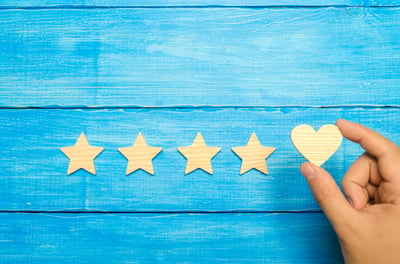October 9, 2025
 by Soundarya Jayaraman / October 9, 2025
by Soundarya Jayaraman / October 9, 2025

For most marketing and growth teams, customer acquisition is the top priority. You spend time and budget figuring out how to bring new customers through the door as cost-effectively as possible. But there’s one metric that often gets overlooked, and it could be the difference between plateauing revenue and sustainable growth: returning customer rate (RCR).
Your returning customer rate (RCR) will vary based on factors like your product type, audience demographics, and industry. But regardless of those variables, it should still be one of your most closely watched metrics.
That’s because RCR tells you how effective you are at retaining customers and building loyalty and, just as importantly, how much you rely on new acquisition to drive growth. A strong RCR also helps you measure the ROI of your marketing efforts and evaluate the overall profitability of your business model.
Beyond revenue, RCR is a reflection of broader performance signals: the quality of your product, the strength of your customer relationships, and the consistency of the experience you deliver. Businesses often use customer loyalty and retention software to monitor these metrics and uncover opportunities to boost repeat purchases.
In the next section, we’ll break down who your returning customers are, why they’re so valuable, and how to increase their contribution to your bottom line.
Here’s a quick summary of everything you need to know about returning customer rate — from definition to strategies and challenges.
The formula to calculate your RCR is simple:
Returning customer rate = (Number of returning customers / Total number of customers) * 100.
You will also find that many of the tools you are using, particularly e-commerce platforms, will calculate this for you.
RCR fluctuates according to industry and the likelihood of regular repeat purchases. According to data from Supliful, the average RCR on Shopify within fashion is 33%, while it is closer to 20% for stores selling electronics.
While there is no set answer to how often you should look at this metric, it’s advisable to keep a close eye on it. Continuously tracking your RCR and comparing month to month or year on year can help you to identify marketing opportunities.
For example, if your RCR typically spikes across a sales period such as Black Friday, you might run a campaign to engage even more of your existing or at-risk customers in the run-up to the peak period.
There isn’t a universal “good” RCR that applies to every business. The ideal range depends on factors like your industry, product type, price point, and purchase frequency. However, industry data provide useful reference points to evaluate your performance.
| Business type | Typical RCR range | Takeaway |
| Overall e-commerce | 15-30% | Most online stores fall in this range and improving even a few points can meaningfully impact profits. |
| Fashion and Apparel | ~25% – 26% | One-off purchases and seasonal demand keep returns moderate. |
| Beauty and Cosmetics | ~25.9% | Consumables + beauty buying cycles push repeat a little higher. |
| Health and supplements | ~29% | Subscription/auto-replenish models help boost repeat buy rate. |
| Home and Furniture | ~14.7% | High-price items, less frequent purchases reduce repeat purchases. |
| Grocery, Food Delivery & Pet Supplies | 30%+ (and up to ~40%+ for some) | Consumables with habitual purchases see the highest repeat purchase. |
Benchmark data sourced from MobiLoud’s report.
While these figures are helpful guideposts, what matters more is how your own RCR changes over time. A business with a 15% rate that increases to 22% over six months is often healthier than one stuck at 30%. Tracking this metric consistently and segmenting it by audience, product line, or campaign helps you pinpoint what’s working and where you can improve.
There are many benefits to improving your RCR, so let’s explore those in more detail.
Firstly, it’s no secret that converting a returning customer to a sale costs less than acquiring a new customer. Bain tells us that a 5% increase in customer retention typically correlates with a 25% increase in profit.
A returning customer is easier to convert because they have shopped with you before and know and trust your brand. This significantly reduces the marketing dollars you need to invest to win them over.
Secondly, returning customers are proven to purchase more frequently and spend more per purchase than new customers.
LoyaltyLion data shows that loyalty program members, the most likely to be returning customers, are six times more likely to return and purchase a second time, and they typically purchase more than two times each year than non-members.
Finally, it’s far easier to convert returning customers without a discount. Too often, new customers compare products from multiple vendors, and the final push across the line comes from the promise of more money off their first purchase.
Returning customers, however, are shopping with you because they already know your product. They’ve used it before, trust its quality, and believe it to be worth paying for. Therefore, they are far more likely to convert at full price rather than at a discounted rate.
There are more reasons to focus on boosting returning customer rates rather than putting all your eggs in the acquisition basket.
Returning customers are your fans, and as such, they are highly likely to recommend your brand to their friends or family members. This is particularly true if you can incentivize them to refer others with a reward.
This is extremely powerful as not only do you unlock a more cost-effective way to acquire new customers, but those customers are more likely to convert.
Referred customers are four times more likely to convert to sales than customers acquired through any other channel. The higher your returning customer rate, the more referrals you will be able to drive.
Suppose you’re a beauty and cosmetics brand, and your average order value (AOV) is typically $60. With an average cost per click (CPC) in e-commerce of $2.69, you spend $2,690 for 1,000 clicks.
However, with an average 5% conversion rate, you will only convert 50 of those 1,000 to a sale, leaving you with an individual customer acquisition cost of $53.80. With the above ACV of $60, this isn’t great news for your profit margins.
Increasing your returning customer rates will allow you to reconvert each customer you’ve paid to acquire at a far lower cost. As the lifetime value of returning customers increases over time, you can offset, and indeed recoup, the high cost of initial acquisition.
As previously mentioned, returning customers have a higher level of trust in your brand and the products you’re selling. This can be extrapolated to a trust that, should they choose to share it, you will use their data responsibly and improve their customer experience.
This is crucial at a time when privacy updates are making it more and more challenging to collect customer data that you can use to personalize your marketing messages. 63% of internet users feel that most companies aren’t transparent about how they use customer data, and 48% have stopped shopping with a store due to privacy concerns.
Returning customers are more likely to share their data, which in turn means that you can market to them far more effectively going forward.
There are many ways to successfully ramp up your RCR, so let’s start with our favorites.
One of the most effective strategies for attracting customers to your store repeatedly is to introduce a tiered loyalty program. Each time a shopper returns to your store, they move closer to advancing to the next tier and unlocking new, higher-value perks and benefits.
While many businesses choose to tier loyalty discounts and shipping rewards, others also use experience-based rewards, such as exclusive content and early access to sales to create a cost-effective way to reward returning customers for their loyalty.
One of the best tiered loyalty programs in e-commerce currently belongs to the jewelry brand Astrid & Miyu.
From £10 vouchers for every 1000 points earned and bonus points events in the bottom tier to first look at new collections and free birthday treats in higher tiers, their cleverly named and on-brand loyalty tiers feature financial and experiential incentives that can be unlocked each time you progress to the next spend threshold.
Our second tip for increasing returning customer rates is to find creative ways to encourage customers to share more information about themselves.
You can then use that data to further personalize your customer experience and marketing messages, ensuring that your customers feel recognized and valued.
Brands are increasingly using loyalty incentives to encourage customers to complete a profile or to take a quiz. This often has dual benefits; customers can be pointed to products or content that best suits their personal attributes, such as skin or hair type, and brands have additional data to provide an improved experience.
Pet brand Edgard and Cooper encourages all website visitors to complete a product quiz to uncover new and relevant products.
Loyalty program members are also incentivized to create a pet profile when they join, sharing information such as their pet’s name and age. This allows Edgard and Cooper to provide relevant recommendations and demonstrate the value of sharing that data.
Our third tip for increasing your returning customer rate is to find as many opportunities as possible to engage with customers between purchases.
Developing a loyalty program that rewards interactions such as social media likes, and shares or product reviews gives you multiple reasons to communicate with customers even if they’re not buying immediately.
This helps you to keep your brand top of mind, ensuring that when the customer is ready to shop, you are the first brand they think of. It also helps the returning customer to build up a points balance faster, which will speed up the time to their next purchase and positively impact your returning customer rate.
Luxury luggage brand BEIS Travel does a fantastic job of motivating their loyalty program members to engage between purchases.
Customers can earn 10 points for social interactions such as following the brand on Instagram, Facebook, YouTube, or TikTok, ensuring that BEIS continually builds their audience while putting more of their promotions and products in front of their existing customers.
They also award 50 points to customers who share their birthday information and 100 points to those who sign up for SMS. Again, this opens up another channel for them to communicate with returning customers while helping them grow their points balances and unlock rewards they will return to redeem sooner.
Consumers are increasingly choosing to shop with brands they have shared passions with. For example, 74% of Gen Z shoppers now say they will pay more for environmentally or socially minded products.
Connecting with your customers on a cause they care about is an incredible way to strengthen your relationship and increase the likelihood of them returning to buy again.
Loyalty programs can provide an effective vehicle for those connections, allowing customers to earn points for positive actions such as recycling packaging or redeeming rewards through charitable donations that benefit others rather than rewards for themselves.
This approach demonstrates to customers that you genuinely care about the same things as they do, which is not only great for the cause you support but also ensures they will continue to shop with you in the future, knowing that by doing so, they can positively impact something they care about.
Ethical health and wellness brand Wild Nutrition offers loyalty program members the opportunity to redeem their points to support three worthy causes. With 1000 points, it’s possible to either plant five trees in the Amazon, plant five trees in Rwanda or donate £5 to Ocean Generation UK.
With this approach, Wild Nutrition can demonstrate that they truly support the same causes while motivating returning customers to order to unlock more of these charitable rewards.
Another highly successful way of engaging returning customers and making them feel part of your brand journey is through experience-based rewards that allow them to give feedback or contribute.
Increasingly, e-commerce businesses are allowing their returning customers and loyalty program members to be part of the product journey, offering top-tier shoppers the chance to join a product feedback session or focus group or the opportunity to become a product tester.
This has the dual impact of making the shopper feel emotionally invested in the products you’re creating while also helping you get more feedback that you can use to produce the kinds of products that will keep your customers coming back for more.
Underwear retailer Lace Laboratory offers the chance to influence product development as part of their platinum loyalty program tier. This is fantastic motivation for shoppers to return, spend more, and progress through the tiers to unlock this benefit.
Source: lacelaboratory.com
While strategy is essential, the right software can make improving your RCR significantly easier. These tools help you track repeat purchases, segment customers, and build experiences that encourage them to come back.
These tools work best when paired with a strong retention strategy, helping you go beyond tracking RCR to actively improving it. Use G2 to research, compare, and choose the best platforms for your business based on real user reviews.
Increasing your returning customer rate can be challenging for several reasons.
For many businesses, the early years are a difficult juggling act where the pressure is on to acquire as many new customers as possible while building the foundations for future success. One key challenge is knowing when to switch to a more balanced approach that incorporates acquisition and retention.
The truth is, as soon as you have a customer, you have a customer who could return and repeat a purchase and positively impact your returning customer rate. This doesn’t mean you need an entire customer retention strategy or loyalty program mapped out from day one.
A simple approach you can build on over time is enough to motivate customers to repeat purchases and increase your returning customer rate.
Another challenge faced by almost all businesses is effectively communicating with customers. Today, there are 12.1 million e-commerce businesses in existence — all clamoring for consumer attention, sending emails, and hoping to get cut through in the inbox.
Standing out is tough, yet you need to stand out to secure returning customers and repeat purchases. This leaves businesses with the headache of trying to collect enough data to personalize experiences in a way that ensures they stand out and are noticed. Only once engaged can a customer be motivated to return and repeat purchases.
Finally, communicating to stakeholders that you are shifting your focus toward increasing your returning customer rate can be challenging. Many senior stakeholders will want to hear how many new customers you’ve acquired, how much new revenue you’ve generated, and how many new products you’ve sold.
It may take some time to win them around to the idea that those numbers are not increasing at the same rate, but that you have diverted effort and attention to another pool of customers who will deliver a far greater return over time.
It’s essential to take all stakeholders on a journey, ensuring that they understand the greater lifetime value of a returning customer and the benefits of increasing returning customer rates.
Repeat rate (sometimes called returning customer rate or repeat purchase rate) measures the percentage of customers who make a second or subsequent purchase within a given period. Retention rate, on the other hand, looks at the percentage of customers who continue to do business with you over a longer timeframe. In other words, repeat rate focuses on repeat transactions, while retention rate reflects ongoing customer loyalty and long-term engagement.
The average returning customer rate varies widely by industry, but most e-commerce businesses fall in the range of 15% to 30%. Sectors with frequent purchases, like food, beauty, or pet supplies, often see rates above 30%, while industries with longer buying cycles, like furniture or electronics, tend to be lower.
A 30% returning rate is considered strong for most industries and usually signals high customer satisfaction and loyalty. In fact, many businesses operate below this level, so consistently maintaining or exceeding 30% often indicates that your retention strategies are working effectively.
Customer return rate is often referred to as the returning customer rate (RCR) or repeat customer rate. All these terms describe the same metric: the percentage of customers who make more than one purchase from your business. However, to avoid confusion with product returns, returning customer rate is the clearer and more accurate term.
A good reactivation rate — the percentage of inactive customers who make a purchase after a period of inactivity — typically ranges from 5% to 15%. However, what is considered “good” depends on your industry and customer lifecycle. Even small improvements in reactivation can significantly boost revenue and lifetime value.
So here concludes our whistle-stop tour of returning customer rates and how to increase them.
We hope that, having read this article, it’s clear to you that your returning customer rate is the number one metric you need to watch.
As privacy laws change, consumers continue to prefer anonymity, and acquisition costs rise further and further, making it harder to win new customers without sizable discounts or financial incentives.
Therefore, your returning customers have become your most profitable audience. Connecting with them, keeping them engaged, and motivating them to return and repeat purchases is far more cost-effective than starting from scratch with brand-new customers. Plus, the more you increase your returning customer rate, the more the lifetime value of your returning customers shoots up.
However, it’s crucial to remember that a good value exchange is required to guarantee a higher returning customer rate. Whether experience-based or transactional, customers must feel they are getting something in return for their loyalty and repeat purchases.
Increasing your returning customer rate is vital to driving sustainable business growth—so good luck!
Ready to boost your returning customer rate? Dive into these customer retention strategies to increase conversions and elevate your business!
Edited by Jigmee Bhutia
This article was originally published in 2024 and has been updated with new information.
Soundarya Jayaraman is a Content Marketing Specialist at G2, focusing on cybersecurity. Formerly a reporter, Soundarya now covers the evolving cybersecurity landscape, how it affects businesses and individuals, and how technology can help. You can find her extensive writings on cloud security and zero-day attacks. When not writing, you can find her painting or reading.
If there's one thing working in marketing has taught me, it's that keeping existing customers...
 by Harshita Tewari
by Harshita Tewari
Loyal customers weave a story for your business that no other stakeholder can.
 by Dwayne Charrington
by Dwayne Charrington
The days of mass marketing are behind us.
 by Holly Hunt
by Holly Hunt
If there's one thing working in marketing has taught me, it's that keeping existing customers...
 by Harshita Tewari
by Harshita Tewari
Loyal customers weave a story for your business that no other stakeholder can.
 by Dwayne Charrington
by Dwayne Charrington


